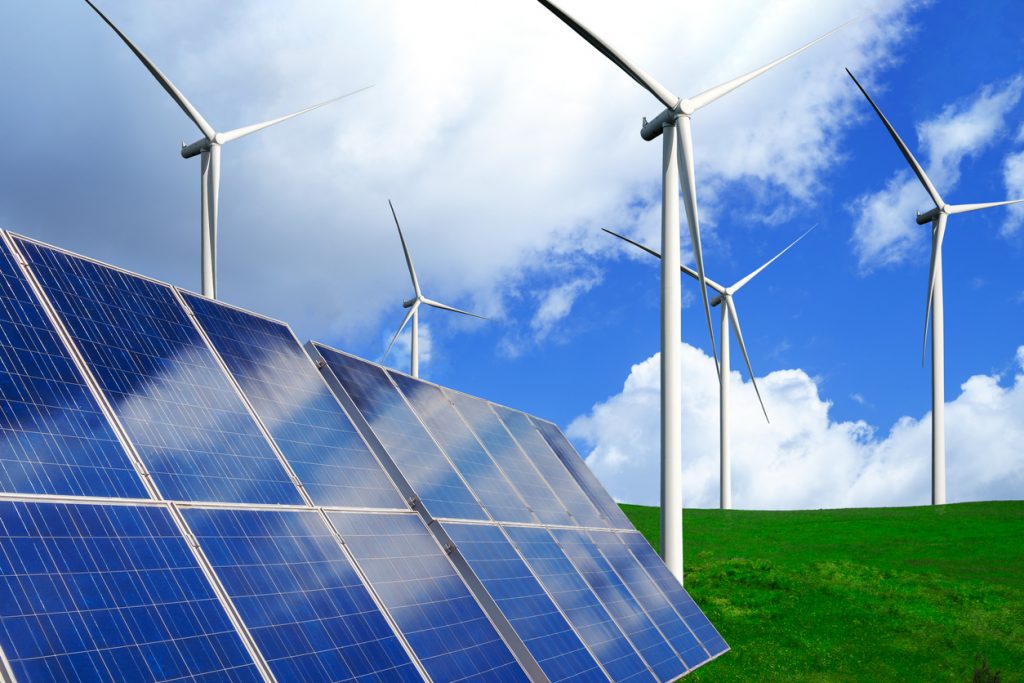The day is an annual celebration recognising the role IP rights play in encouraging innovation and creativity, and this year’s theme from the World Intellectual Property Organisation (WIPO) is “Innovate For a Green Future”.
In his World IP Day message, WIPO Director General Francis Gurry highlighted the growing global demand for energy, which is predicted to rise by 30 per cent by 2040. And he emphasised the importance of fostering innovation, and supporting the development or robust IP systems to incentivise and support it, in order to develop the clean energy systems required to meet that demand.
Senior associate Giles Pinnington is a Chartered UK and European Patent and Trade Mark Attorney with Marks & Clerk and welcomed the spotlight being put on green innovation. “It is so important to recognise the role intellectual property systems play in supporting a green future. The innovation we are seeing in the green energy sector is particularly exciting with some truly cutting edge projects underway that could shape the future of energy production in ways we could never have imagined just a few decades ago", he said.
“It’s not just green energy companies where we’re seeing great strides, but in the oil and gas sector we’re also seeing some fantastic innovation as it adapts for the future.”
Our existing infrastructure is already tailored to the use of hydrocarbons, which will continue for years to come. At least for the next few years, it is likely that a very significant proportion of energy will come from oil and gas.
Below Giles highlights some interesting green energy projects underway today:
- Artificial photosynthesis: It may sound like science fiction but scientist Heinz Frei is taking the lead from Mother Nature by carrying out work on artificial photosynthesis – the chemical reaction that allows plants to turn carbon dioxide into cellular fuel. He is essentially rebuilding the leaf in the form of solar fuel tiles in exciting work that could pave the way for generating renewable energy from CO2.
- Hydrogen direct reduction steel: The production of steel is an incredibly energy intensive process and coal is typically used. The steel industry is responsible for around 7% of global CO2 emissions. But moves are being made to decarbonise this industry and Svenskt Stal (Swedish Steel) – which is part owned by the Finnish government – announced at the beginning of this year that it was set to use fossil-free, renewable hydrogen for thermal heat. It’s a move that will play a notable role in cutting carbon emissions in both Sweden and Finland, and would go some way to meet Sweden’s aim of carbon neutrality by 2045.
- Nanocatalysts: Using the process of hydrogenation of CO2 to create hydrocarbons is very expensive for two reasons – hydrogenation requires an extremely high temperature, plus the catalysts needed can be expensive to produce. But the creation of a new catalyst could be an exciting turning point thanks to researchers at the University of Southern California and the National Renewable Energy Lab. The compound they have created could potentially be used to convert carbon dioxide into hydrocarbons, and the process involves much lower temperatures than used to form existing catalysts.
Reinforcing the scale of innovation in the energy sector, the latest data from the European Patent Office released in March showed a 13% rise in patent applications from the UK, while global EPO applications in the energy category rose 5.5%.
How will these innovations shape change in the next years?
Our existing infrastructure is already tailored to the use of hydrocarbons, which will continue for years to come. At least for the next few years, it is likely that a very significant proportion of energy will come from oil and gas. However, countries are looking to reduce the amount of carbon entering the atmosphere and hydrocarbons are not in infinite supply, so it is important that innovation starts now so that we have the required technologies to help smooth the long-term transition towards alternative energy sources.
. Patents are in some sense a type of insurance taken out to mitigate or prevent economic damage caused by competitors being able to realise the benefits of a technology without having to take on any of the risk and costs associated with developing the technology.
By finding better and more efficient ways of generating hydrocarbons from carbon dioxide and water, it is possible to have net-zero carbon emissions, since the carbon present in the hydrocarbons is taken from the atmosphere before being released again when the fuel is used. Advances in technology could change how we view hydrocarbons from being an energy source to being an energy storage means. There is a long way to go in this regard, but with continuous innovation, we will ultimately get there.
There are clear hurdles ahead. The amount of hydrocarbons used every day across the world is vast and there is by no means enough capacity to replace the use of hydrocarbons with alternative energy sources, like wind, wave, solar, and nuclear. Indeed, the advantages of hydrocarbons are the reason why they have been the primary source of energy for the world since the beginning of the industrial revolution, so any move away will be gradual. Even so, as technology progresses, we may be able to retain the advantages of hydrocarbons by continuing to develop new technologies.
What role does IP play here? What is its importance?
Intellectual property rights, such as patents, provide a mechanism by which the creators of new technologies can protect their investments and enterprise. Without formal intellectual property rights, companies would be unable to protect their assets and would be unable to stop others from profiting off the back of their efforts. Patents are in some sense a type of insurance taken out to mitigate or prevent economic damage caused by competitors being able to realise the benefits of a technology without having to take on any of the risk and costs associated with developing the technology. Simply put, if there is a technology which offers a commercial advantage of any kind, it will be adopted by competitors unless there is some way to stop them. For technical innovations, this is provided by patents.
According to a report by the Frankfurt School, there has been unprecedented investment in renewable energy generation worldwide, but Europe is falling behind with regards to green energy innovation, with China, Japan, South Korea and the US leading the way.
Looking more broadly, in return for the monopoly protection afforded by patents, the deal is that details of the new technology are disclosed in the patent documents, which are published and thereby made available to the public 18 months after filing. This spurs further innovation by inducing others to find new and potentially better ways of solving problems. In addition, by being publicly available, there is more information in the public arena for third parties to develop technologies by seeing what has been done before.
It is also possible to licence and sell intellectual property rights. Licensing allows companies to generate income from their innovative technologies from regions of the world where they do not have operations and can generate income without incurring capital expenditure or having the overheads of operating the technology, whether that is the manufacture of an innovative product or the operation of a patented process.
Finally, under the Patent Box regime in the UK, a lower rate of corporation tax (10%) is applied to profits which are attributed to patented inventions. As such, if a patented product is successful, the owner or exclusive licensee of a patent may reduce its tax burden significantly. The reduction is tax can certainly outweigh any costs associated with obtaining and maintaining a patent.
The majority of investment in green energy is coming from outside Europe, so Europe may be able to benefit from the advantages of innovations coming out of Asia and the US.
Are there any different aspects of IP protection when it regards green energy?
The UK Intellectual Property Office supports green innovation by way of the Green Channel. The Green Channel was introduced in May 2009 with the intention of encouraging the adoption of green technologies which have an environmental benefit.
There are no additional costs associated with Green Channel applications. There is no automatic Green Channel entry for green technologies, but it simply requires a request to be filed which indicates how the invention is environmentally friendly. For certain technologies, such as those relating to wind turbines or solar panels, a simple statement without explanation is generally enough. For technologies having less obvious green credentials, slightly more reasoning is required.
If the application is accepted into the Green Channel, the patent application will undergo accelerated prosecution with the intention of obtaining a granted patent earlier than would have otherwise been the case.
Whether or not the EC will be able to meet its carbon neutrality target of 2050 is unclear, but with continued innovation from across the world, it is becoming closer every day.
What jurisdictions are leading innovation in this area?
According to a report by the Frankfurt School, there has been unprecedented investment in renewable energy generation worldwide, but Europe is falling behind with regards to green energy innovation, with China, Japan, South Korea and the US leading the way. Over the past decade, China has committed US$758 billion in renewable capacity, with the US following on US$356 billion and Japan third with US$202 billion. As a whole, Europe committed US$698 billion over the past decade.
Do you think these patents will help the European Commission meet its target of becoming carbon neutral in 2050 (i.e., is there enough investment in this sector)?
Most inventions are slight improvements on what has gone before. There are very few innovations which are truly revolutionary and completely change an industry. The path to achieving carbon neutrality will not rely on a single innovation, but the combination of myriad incremental steps over time. There is a huge amount of research and development continuing in the green energy sector and we will slowly edge towards carbon neutrality.
In order to achieve carbon neutrality, further investments and innovation will need to be made not only in fuel cells and batteries for end users to use, but also in electrical generation, which is required to charge the batteries and produce the hydrogen needed.
The majority of investment in green energy is coming from outside Europe, so Europe may be able to benefit from the advantages of innovations coming out of Asia and the US. Whether or not the EC will be able to meet its carbon neutrality target of 2050 is unclear, but with continued innovation from across the world, it is becoming closer every day.





















